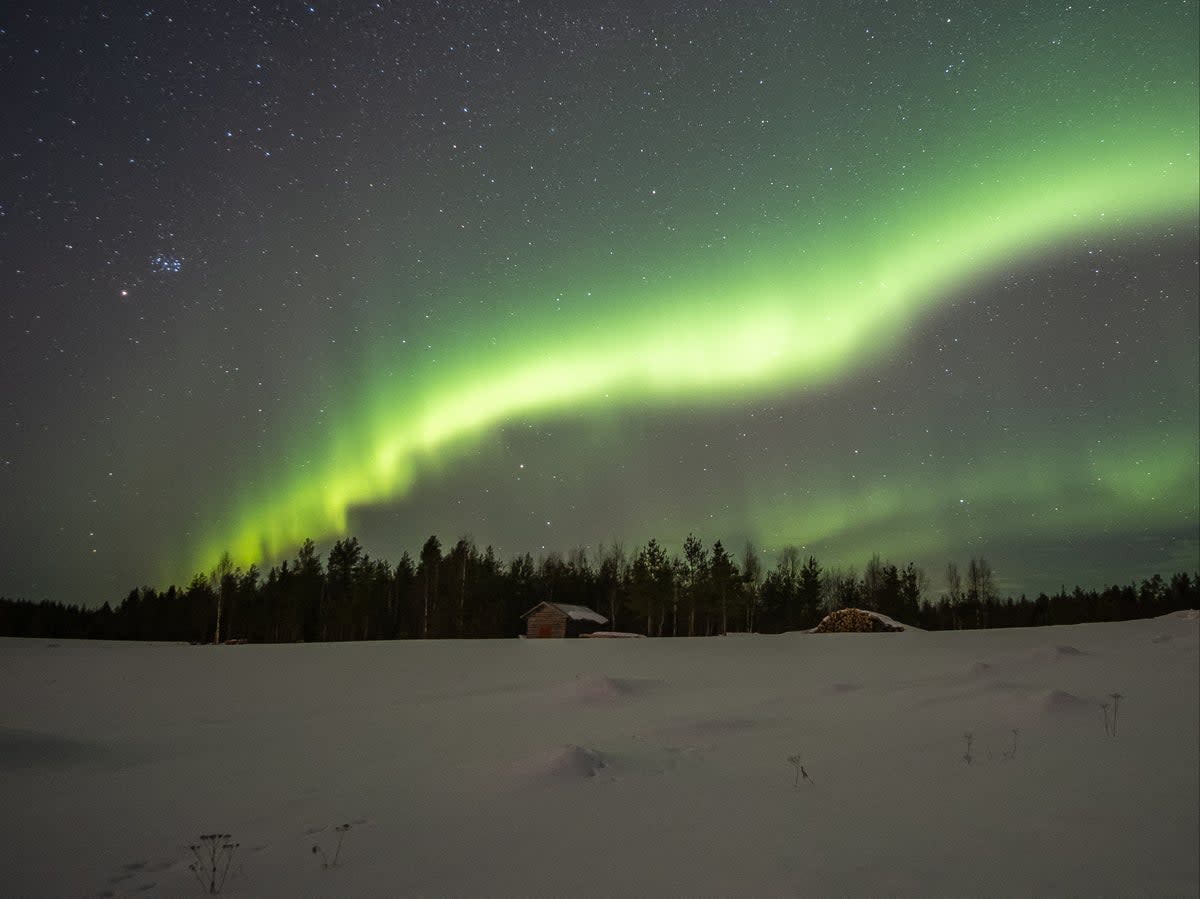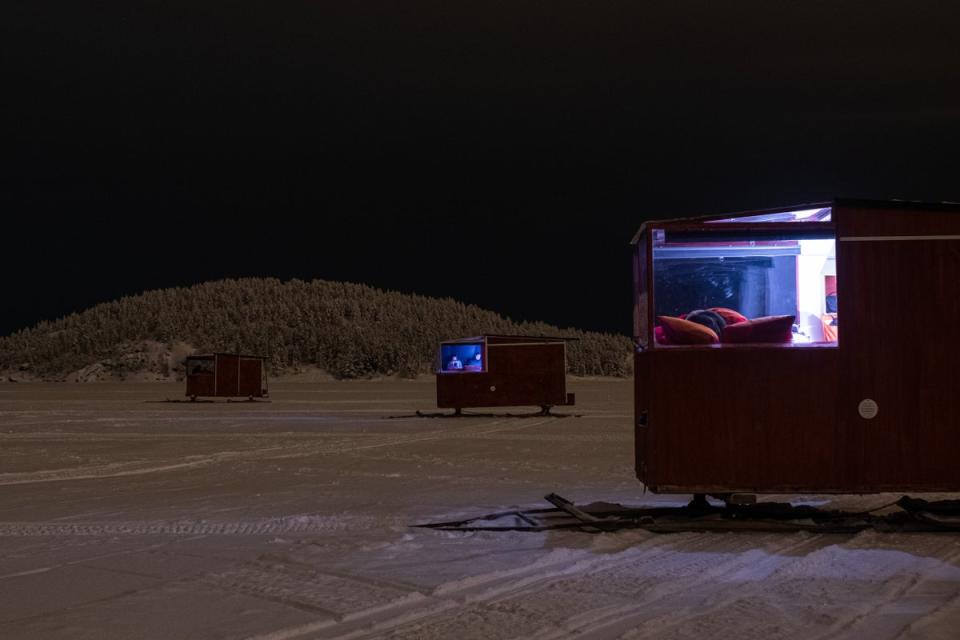How to have the best Christmas holiday in Lapland – without kids

It’s no secret that Finnish Lapland is Santa Central, a territory in which the White-Bearded One sits in permanent residence, extending the festive season beyond its allotted schedule. The Santa Claus Village on the Arctic Circle at Rovaniemi, the provincial capital, comes charmingly alive with festive glitter at and around Christmas itself, with elves and reindeer galore against a backdrop of plentiful snow, as well as the red-gowned governor making himself conspicuous. But if you’re looking for a less Santa-saturated experience, with or without the kids, in an authentic Lapland setting, you’d do well to head even further north. In fact, about as far north in European terms as it’s possible to go.
Inari, a compact community 350 kilometres north of the Arctic Circle on the edge of a vast lake of the same name – Finland’s third largest – is a good choice at which to be enchanted by Lapland’s special winter magic, at and either side of the Christmas and New Year season. That season falls within the period of deep winter in Arctic Finland called kaamos, the Polar Night during which the sun sulks below the horizon without bothering to rise above it. If poolside tans and cocktails are a priority for your midwinter break, you won’t be heading in this direction in the first place, but visitors are invariably thrilled beyond expectation by the magical Arctic half-light at this time.

“Polar Night is an especially beautiful season,” says Anne Karhu-Angeli, whose Sámi family runs the Angeli Reindeer Farm near Inari. Visits can be booked in advance to those who seek an introduction to the authentic life of the local Sámi minority, the only ethnic grouping in the EU to have earned indigenous European status. “We are busy with our reindeer but the stillness of nature calms everything down. Lakes freeze up. Wild birds migrate southwards. Wild animals hibernate.”
Reindeer herding keeps her family tightly connected to Sámi culture. “We speak the Inari Sámi language and we use materials sourced from the animals – antlers and hides – for traditional Sámi handicraft. Our grandparents still teach Sámi traditions to our children. Our visitors learn about our culture, the revival of our ancient Inari Sámi language, and our sustainable lifestyle. Our connection with the natural environment seems to inspire our guests.”
The stillness of nature calms everything down. Lakes freeze up. Wild birds migrate southwards. Wild animals hibernate
Anne Karhu-Angeli
That sparsely populated environment enjoys a luxurious, all-encompassing silence. Pastel shades of violet, pink and blue radiate from the snowbound landscape. The heavenly illuminations of the Northern Lights cast another spell. Inari sits directly within the optimal aurora borealis viewing zone, so chances are good of experiencing a ‘show’ during the September-to-April season, clear skies permitting. Any aurora-obscuring light pollution from the services in Inari village, including two supermarkets and a couple of souvenir shops, is less intense than in Lapland’s resorts, and easy to escape by strolling down to the frozen lake.
To experience even starrier skies, head out to Korpikartano, a former school converted to a remote lakeshore hotel some 30 kilometres away from the village. Korpikartano’s staff are as disappointed as you are if you leave without an aurora sighting.
Another novel option is to spend a night in one of the heated Mobile Cabins, towed onto the ice-covered lake by snowmobiles. “I had this idea when I was working as a guide for Northern Lights ski tours,” says Esko Aarnio, the cabin host. “We might see the aurora, but it was always cold. I thought it would be great to stay out longer so I thought of building shelters on the ice to sleep in. The cabins started to be popular so we built a bigger onshore ‘base camp’ cabin where guests can leave their bags and have breakfast in the morning.”

Perhaps Inari’s warmest, most comfortable retreat is the freshly renovated and reopened Wilderness Hotel Juutua, close to rapids on the banks of the Juutua river running into the lake. The hotel previously at these premises was known for housing one of the best restaurants in northern Finland, an iconic reputation the new owners intend to sustain. At Restaurant Aanaar (Sámi for Inari), expect to be served fresh fish, such as Arctic char and salmon, as well as reindeer steaks or stew, mushrooms in season, and desserts with vitamin C-rich cloudberry, which grows abundantly here. There’s a special five-course menu included in the hotel’s Arctic Juutua and Juutua Winter Adventure Week packages. In the village, the cheerful PaPaNa Bar serves good pizzas and belting karaoke, as well as local live music acts.
“The Inari area has particularly diverse landscapes, with lakes and rivers and old forests, as well as upland fells,” says Juutua’s travel designer, Maaret Mattus-Tyni. The snowbound terrain lends itself to different winter activities, including reindeer and husky sled rides, snowmobile excursions, and snowshoe explorations. Illuminated cross-country ski tracks lead from near the Hotel Juutua along the river and into the forest. The hotel provides Arctic winter gear and clothing.
Our Santa has a reindeer-fur coat and reindeer-fur boots and speaks Sámi to us. In fact, he’s more like any old Sámi man
Mattus-Tyni has a Sámi family background, and the Inari region is home to one of three groups in Finland with their own languages (you’ll see signage in both Finnish and the local Sámi variant). Sámi people claim an original homeland stretching across the northernmost areas of Finland, Norway, Sweden and Russia.
Siida is the Sámi word for a reindeer herding site or community, and it’s also the name of the Sámi Museum and Nature Centre in Inari, housing a recently expanded exhibition of the people’s history, culture and lifestyle. Since visitors are in the heart of a unique and endangered native culture, it seems only courteous to pay a visit. It can get extremely cold in Lapland in the depths of winter, with temperatures plummeting as low as -30C, and the museum serves as an informative warm-up venue – although you’ll need to wrap up to explore the adjacent outdoor museum of traditional Lapland dwellings. Finland’s Sámi Parliament sits in the Sajos Sámi Cultural Centre, an elegant timber building on the edge of the village.
All this, and no mention of Santa? In fact, Joulupukki, as he’s known in Finland, still makes his presence felt here, as he does across the whole of Finland. “Sámi people don’t have their own special Christmas traditions,” says Karhu-Angeli. “But in our family we celebrate in the Finnish way – except we have reindeer meat on our table instead of ham. And our Santa has a reindeer-fur coat and reindeer-fur boots and speaks Sámi to us. In fact, he’s more like any old Sámi man.”

The difference is, in Inari not everything revolves around the man with a bag – and, in this grown-up’s opinion, a holiday here is so much the better for it.
Travel essentials
Getting there
Trying to fly less?
It’s possible to travel by train and ferry to Helsinki, going by rail to Stockholm via Hamburg and from there to Finland by sea. Once in Helsinki, the Santa Claus Express runs two to three times daily to Rovaniemi, from where there’s a bus to Inari.
Fine with flying
Finnair flies from Helsinki to Ivalo up to three times daily (1hr 40 min, including stop at Rovaniemi), from which an airport shuttle bus departs for Inari 20 mins after each arrival (40 min).
Alternatively, buses depart from Rovaniemi to Inari twice a day (5hr).
Staying there
In Inari, Wilderness Hotels operate the Wilderness Hotel Juutua (doubles from £163) as well as Wilderness Hotel Inari & Igloos (doubles from £154). wildernesshotels.fi
Former school turned hotel, Korpikartano has doubles from £80. korpikartano.fi
More information
Visit Inari runs activity tours as well as Hotel Inari in the village: visitinari.fi.
The Sámi Parliament provides a Responsible Visitors’ Guide to the World of Sámi Culture and Sámi Homeland in Finland: samediggi.fi/saamelaismatkailu

 Yahoo News
Yahoo News 
